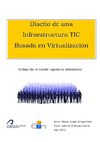Please use this identifier to cite or link to this item:
https://accedacris.ulpgc.es/jspui/handle/10553/11237
| Title: | Diseño de una infraestructura TIC basada en virtualización | Authors: | Ortega Pérez, Miguel Ángel | Director: | Blasio, Gabriel de | UNESCO Clasification: | 120317 Informática | Keywords: | Virtualización Diseño Integral Disponibilidad Alta, et al |
Issue Date: | 2013 | Abstract: | Las necesidades básicas de las empresas suelen ser las mismas, ya sea una empresa grande que pequeña, la infraestructura sobre la que montan sus procesos de negocio y las aplicaciones para gestionarlos suelen ser casi iguales. Si dividimos la infraestructura TIC de una empresa en hardware, sistema y aplicaciones, podemos ver que en la mayoría de ellas el sistema es casi idéntico. Además, gracias a la virtualización, que ha entrado de manera arrolladora en el mundo de la informática, podemos independizar totalmente el software del hardware, de forma que obtenemos una flexibilidad enorme a la hora de planificar despliegues de infraestructura. Sobre estas dos ideas, uniformidad de sistema e independencia de hardware, son sobre las que se va a desarrollar el siguiente TFG. Para el desarrollo de la primera de ellas se realizará el estudio de la infraestructura básica ( sistema) que cualquier empresa suele tener. Se intentará dar una solución que sea válida para una gran cantidad de empresas de nuestro entorno y se realizará el diseño del mismo. Con la segunda idea desarrollaremos un sistema basado en servicios, que sea lo suficientemente completa para poder dar respuesta a las necesidades vistas pero, a su vez, suficientemente flexible para que el crecimiento en capacidades o servicios se pueda realizar de forma sencilla sin que la estructura del sistema, o sus módulos deban modificarse para realizarlos. Por tanto, vamos a realizar un diseño integral y completa, de forma que será tanto de hardware como de software, haciendo énfasis en la integración de los sistemas y la interrelación entre los distintos elementos de ellos. Se dará, a su vez, la valoración económica del mismo. Por último, y como ejemplo de la flexibilidad del diseño elegido veremos dos modificaciones sobre el diseño original. El primero de ellos será una ampliación para dar mayor seguridad en cuanto a redundancia de almacenamiento y, ya en un paso definitivo, montar un CPD remoto. El segundo de ellos será un diseño de bajo coste, en el que, mantenimiento los mismos servicios, bajaremos el coste del diseño con productos con algo menos de prestaciones, pero manteniendo la solución en conjunto unos altos niveles de calidad y servicio. The basic needs of companies are often the same, whether a large company that small, the infrastructure on riding their business processes and applications to manage them are often nearly equal. If we divide the ICT infrastructure of a company in hardware, system and applications, we can see that in most of them the system is almost identical. Moreover, through virtualization, which has entered a landslide in the computer world, we can be fully detached hardware software, so that we get a huge flexibility when planning infrastructure deployments. On these two ideas, uniformity and independence of hardware system,aRe about to be developing the next TFG. For the development of the first one will be the study of basic infrastructure (or system) that any company usually has. Will try to find a solution that is valid for a lot of companies in our area and will take place on design. With the second idea will develop a service-based system that is complete enough to be able to respond to the needs views but at the time, sufficiently flexible to growth in capabilities or services can be performed easily without the structure the system or its modules to be modified to make them. Therefore, we will conduct a full and complete design, so that will be both hardware and software, emphasizing the integration of systems and the interrelation between the different elements of them. It will, in turn, economic valuation of the same. Finally, as an example of the flexibility of the design chosen will see two modifications to the original design. The first will be an extension to provide greater security for redundancy storage and, as a final step, mount a remote data center. The second one will be a low cost design, in which maintaining the same services, we will lower the cost of product design with slightly less performance, while maintaining the solution set high standards of quality and service. |
Department: | Informática y Sistemas | Faculty: | Escuela de Ingeniería Informática | Degree: | Grado en Ingeniería Informática | URI: | https://accedacris.ulpgc.es/handle/10553/11237 | Rights: | by-nc-nd |
| Appears in Collections: | Trabajo final de grado |
En el caso de que no encuentre el documento puede ser debido a que el centro o las/os autoras/es no autorizan su publicación. Si tiene verdadero interés en el contenido del mismo, puede dirigirse al director/a o directores/as del trabajo cuyos datos encontrará más arriba.
Show full item recordItems in accedaCRIS are protected by copyright, with all rights reserved, unless otherwise indicated.
